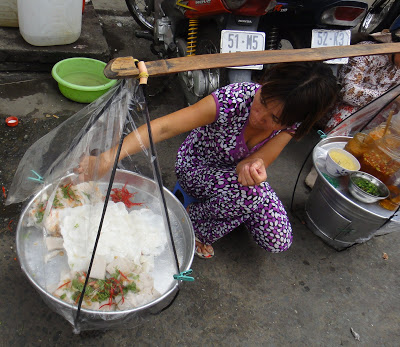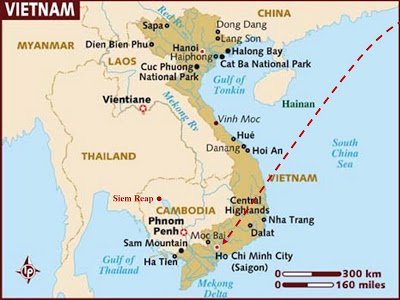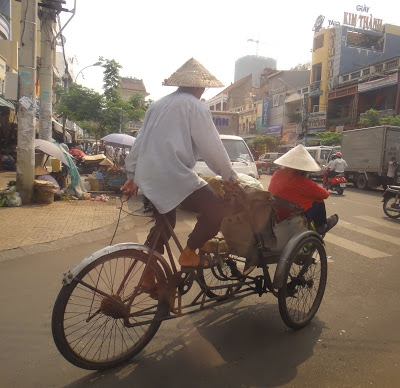
“Is Ho Chi Minh City still called ‘Saigon’?” I ask. Tring smiled hesitantly. “People here—we like to hear it,” she said. “On forms we have to write Ho Chi Minh City, but everyone says Saigon.”
“Saigon is colorful and crowded and loud. People are everywhere—on plastic stools and chairs sipping Vietnam’s excellent coffee, squatting by fruit stands, poring through bins at the flower market around the corner from our hotel, practicing tai chi in the park. A group of old ladies opens vibrant silk fans and swings them in a coordinated arch for their morning exercise” (Stripes Kanto, “Land of Ascending Dragon Lures with Beauty, More” by Mari Krueger, February 2011).
So many colors—the deep green of the vegetation fanning over parks and street corners, overflowing throughout the fruit stands and flower shops near the Ben Thang Market.
“The first person I see outside the hotel in the morning wears the iconic Vietnamese conical hat. Vietnam is off to a good start. A girl in bright red traditional Vietnamese dress, or ao dai, zooms around a dusty corner on her motorbike. I’d heard Saigon had a lot of motorbikes, but I’m still amazed. They’re literally everywhere—huge swarms at stoplights, zipping over sidewalks, always filling the streets, the medians, the alleyways. There are lots of cars, too, but the motorbikes swirl around and between them like water; the flow of them never stops. Everyone is wearing the mandatory bike helmet, sometimes even a bike helmet and a conical hat” (Stripes Kanto, “Land of Ascending Dragon Lures with Beauty, More” by Mari Krueger, February 2011).
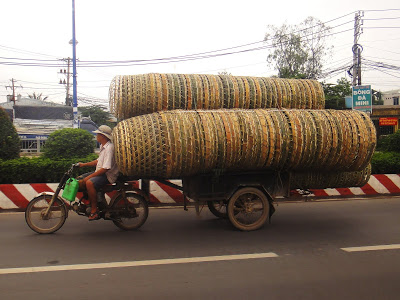
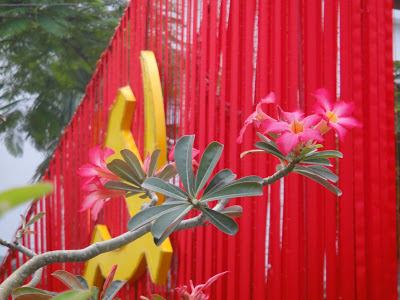 A man folds a chicken under his arm and saunters along the river. Just outside the city rice farmers stoop over their harvest, protected from the hazy morning sun by broad conical hats. A rickety bridge on stilts wobbles over an irrigation ditch. Two woman drive by on a scooter, one holding a child in her lap, the other cradling a sleeping baby…on the highway. Thatched roofs shade plastic chairs and hammocks and coconuts. Pink frangipani blooms within a cobalt pot. Circles of rice paper dry on a bamboo rack in the sun. Stalks of lemongrass grow around houses for cooking and to keep bugs out. A man chops ice from a massive ice block in the back of his truck. Rubber trees grow in straight lines, once owned by the French but now the government. A worker here can make an excellent salary of $200-300 per month, far more garment factory workers who earn just $80-150 per month.
A man folds a chicken under his arm and saunters along the river. Just outside the city rice farmers stoop over their harvest, protected from the hazy morning sun by broad conical hats. A rickety bridge on stilts wobbles over an irrigation ditch. Two woman drive by on a scooter, one holding a child in her lap, the other cradling a sleeping baby…on the highway. Thatched roofs shade plastic chairs and hammocks and coconuts. Pink frangipani blooms within a cobalt pot. Circles of rice paper dry on a bamboo rack in the sun. Stalks of lemongrass grow around houses for cooking and to keep bugs out. A man chops ice from a massive ice block in the back of his truck. Rubber trees grow in straight lines, once owned by the French but now the government. A worker here can make an excellent salary of $200-300 per month, far more garment factory workers who earn just $80-150 per month. 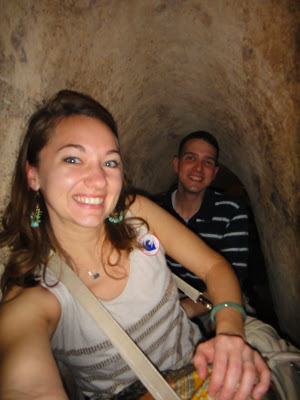 “Just 40 kilometers from Saigon are the old Cu Chi Tunnels once inhabited by the Viet Cong—troops fighting for the north and communism in the south during the Vietnam War (or the American War if you’re in Vietnam). More than 10,000 people lived in the 250 kilometers of suffocatingly small tunnels and underground rooms” (Stripes Kanto, “Land of Ascending Dragon Lures with Beauty, More” by Mari Krueger, February 2011).
“Just 40 kilometers from Saigon are the old Cu Chi Tunnels once inhabited by the Viet Cong—troops fighting for the north and communism in the south during the Vietnam War (or the American War if you’re in Vietnam). More than 10,000 people lived in the 250 kilometers of suffocatingly small tunnels and underground rooms” (Stripes Kanto, “Land of Ascending Dragon Lures with Beauty, More” by Mari Krueger, February 2011). Everyone—men, women, the elderly and children—was counted on to be a soldier, said the propaganda video playing in one of the tiny half-underground rooms. They constructed lots of innovative and sickening booby traps. Between the working trap demonstrations and a tour of one of the largest tunnels (no ventilation, we nearly had to crawl, and it felt like it went on and on), the tunnels were a little nauseating. Chris went down to the shooting range and shot a bunch of rounds out of a M1 Garand because it’s the same type of gun he drilled with as a Ross Volunteer at Texas A&M. 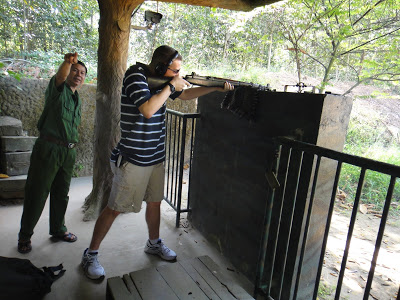 Driving back to the city we see a water buffalo nosing a chicken, sunlight gleaming off a rice worker’s hat and the emerald fields surrounding him, dog statues on gate posts to protect the home, high school girls wearing white ao dai school uniforms, a guy riding a motorbike carrying a 20-ft bamboo ladder. I feel like a chump compared to how much these scooters carry. We pass a wedding party and Tring says this is bad luck. Businessmen starting a venture don’t want to see: 1. any cat, 2. a wedding party (increasing one’s problems), or 3. any woman (because women are trouble).
Driving back to the city we see a water buffalo nosing a chicken, sunlight gleaming off a rice worker’s hat and the emerald fields surrounding him, dog statues on gate posts to protect the home, high school girls wearing white ao dai school uniforms, a guy riding a motorbike carrying a 20-ft bamboo ladder. I feel like a chump compared to how much these scooters carry. We pass a wedding party and Tring says this is bad luck. Businessmen starting a venture don’t want to see: 1. any cat, 2. a wedding party (increasing one’s problems), or 3. any woman (because women are trouble). 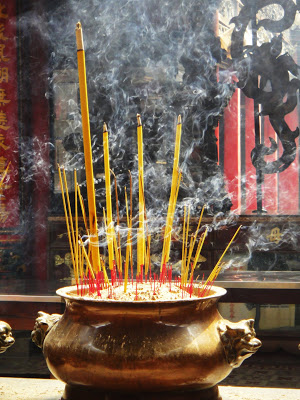 In Chinatown, or Cholon, we visit the oldest temple in Saigon, the Thien Hau Pagoda, where coils of incense burn for a week or even months. From there we walk through Binh Tay Market, which is hawking the highest mounds of cheap crap I’ve ever seen—thin plastic tubs; outdated, badly-glued accessories; floppy early-90s-style hats; unappetising bins of cellophane-wrapped candy; mass-packaged flip-flops.
In Chinatown, or Cholon, we visit the oldest temple in Saigon, the Thien Hau Pagoda, where coils of incense burn for a week or even months. From there we walk through Binh Tay Market, which is hawking the highest mounds of cheap crap I’ve ever seen—thin plastic tubs; outdated, badly-glued accessories; floppy early-90s-style hats; unappetising bins of cellophane-wrapped candy; mass-packaged flip-flops. 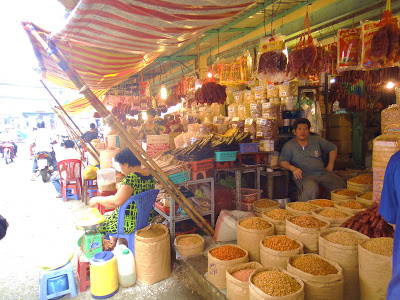
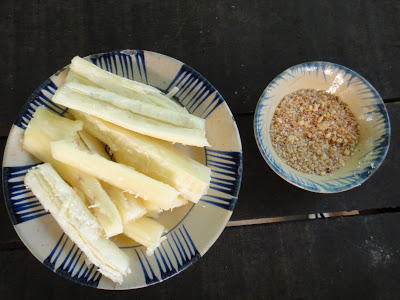 I’m wondering when we’ll have lunch, but we continue on to the Reunification Palace. We only got about five hours of sleep after a long day of travel and I’m feeling weary and in serious need of a lunch break. Over five and a half slices of roasted tapioca root mid-morning Tring told us, “This is your lunch.” I thought she was kidding or I would have asked for seconds.
I’m wondering when we’ll have lunch, but we continue on to the Reunification Palace. We only got about five hours of sleep after a long day of travel and I’m feeling weary and in serious need of a lunch break. Over five and a half slices of roasted tapioca root mid-morning Tring told us, “This is your lunch.” I thought she was kidding or I would have asked for seconds.
 Driving back to the city we see a water buffalo nosing a chicken, sunlight gleaming off a rice worker’s hat and the emerald fields surrounding him, dog statues on gate posts to protect the home, high school girls wearing white ao dai school uniforms, a guy riding a motorbike carrying a 20-ft bamboo ladder. I feel like a chump compared to how much these scooters carry. We pass a wedding party and Tring says this is bad luck. Businessmen starting a venture don’t want to see: 1. any cat, 2. a wedding party (increasing one’s problems), or 3. any woman (because women are trouble).
Driving back to the city we see a water buffalo nosing a chicken, sunlight gleaming off a rice worker’s hat and the emerald fields surrounding him, dog statues on gate posts to protect the home, high school girls wearing white ao dai school uniforms, a guy riding a motorbike carrying a 20-ft bamboo ladder. I feel like a chump compared to how much these scooters carry. We pass a wedding party and Tring says this is bad luck. Businessmen starting a venture don’t want to see: 1. any cat, 2. a wedding party (increasing one’s problems), or 3. any woman (because women are trouble).  In Chinatown, or Cholon, we visit the oldest temple in Saigon, the Thien Hau Pagoda, where coils of incense burn for a week or even months. From there we walk through Binh Tay Market, which is hawking the highest mounds of cheap crap I’ve ever seen—thin plastic tubs; outdated, badly-glued accessories; floppy early-90s-style hats; unappetising bins of cellophane-wrapped candy; mass-packaged flip-flops.
In Chinatown, or Cholon, we visit the oldest temple in Saigon, the Thien Hau Pagoda, where coils of incense burn for a week or even months. From there we walk through Binh Tay Market, which is hawking the highest mounds of cheap crap I’ve ever seen—thin plastic tubs; outdated, badly-glued accessories; floppy early-90s-style hats; unappetising bins of cellophane-wrapped candy; mass-packaged flip-flops. 
 I’m wondering when we’ll have lunch, but we continue on to the Reunification Palace. We only got about five hours of sleep after a long day of travel and I’m feeling weary and in serious need of a lunch break. Over five and a half slices of roasted tapioca root mid-morning Tring told us, “This is your lunch.” I thought she was kidding or I would have asked for seconds.
I’m wondering when we’ll have lunch, but we continue on to the Reunification Palace. We only got about five hours of sleep after a long day of travel and I’m feeling weary and in serious need of a lunch break. Over five and a half slices of roasted tapioca root mid-morning Tring told us, “This is your lunch.” I thought she was kidding or I would have asked for seconds. Hours later now, it’s starting to look like we’ve been put on the Vietnamese Starvation Diet. Wait—I find some rice crackers I’d stowed in Chris’ backpack. Excellent, I can rebound. I munch on my first of two Japanese crackers while Tring goes to buy entry tickets. Chris is off photographing the building’s facade when she returns. She sees the cracker and wrinkles her nose.
“You’re already hungry?” she asks disparagingly. I smile flatly in a way no one has ever failed to recognize as annoyance, but she looks me up and down and finishes, “Again?” I continue to smile wanly and say nothing. She turns away.
Tiny woman, I will eat you and your disdain! It’s 2:30pm! That’s 4:30pm in Japan! I am a person who needs lunch! 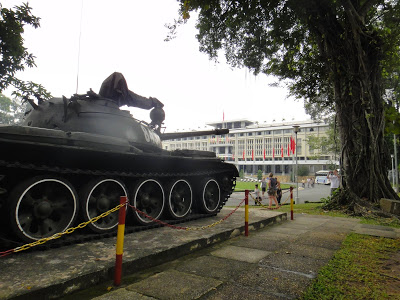 “Inside the palace grounds two replica tanks are pointed at the former Independence Palace in a tribute to the fall of Saigon when the North Vietnamese Army broke through the gates with real ones. It’s a pointed reminder of who is in control. We walk around inside, through the frozen 1970s-era rooms down to the former South Vietnamese President’s underground war room. From the top floor we almost see the US Embassy between waving tree branches; we drive by the US Consulate on the old embassy plot after taking a turn around the old post office and Notre Dame, a cathedral built entirely with imported French stones” (Stripes Kanto, “Land of Ascending Dragon Lures with Beauty, More” by Mari Krueger, February 2011).
“Inside the palace grounds two replica tanks are pointed at the former Independence Palace in a tribute to the fall of Saigon when the North Vietnamese Army broke through the gates with real ones. It’s a pointed reminder of who is in control. We walk around inside, through the frozen 1970s-era rooms down to the former South Vietnamese President’s underground war room. From the top floor we almost see the US Embassy between waving tree branches; we drive by the US Consulate on the old embassy plot after taking a turn around the old post office and Notre Dame, a cathedral built entirely with imported French stones” (Stripes Kanto, “Land of Ascending Dragon Lures with Beauty, More” by Mari Krueger, February 2011).
 “Inside the palace grounds two replica tanks are pointed at the former Independence Palace in a tribute to the fall of Saigon when the North Vietnamese Army broke through the gates with real ones. It’s a pointed reminder of who is in control. We walk around inside, through the frozen 1970s-era rooms down to the former South Vietnamese President’s underground war room. From the top floor we almost see the US Embassy between waving tree branches; we drive by the US Consulate on the old embassy plot after taking a turn around the old post office and Notre Dame, a cathedral built entirely with imported French stones” (Stripes Kanto, “Land of Ascending Dragon Lures with Beauty, More” by Mari Krueger, February 2011).
“Inside the palace grounds two replica tanks are pointed at the former Independence Palace in a tribute to the fall of Saigon when the North Vietnamese Army broke through the gates with real ones. It’s a pointed reminder of who is in control. We walk around inside, through the frozen 1970s-era rooms down to the former South Vietnamese President’s underground war room. From the top floor we almost see the US Embassy between waving tree branches; we drive by the US Consulate on the old embassy plot after taking a turn around the old post office and Notre Dame, a cathedral built entirely with imported French stones” (Stripes Kanto, “Land of Ascending Dragon Lures with Beauty, More” by Mari Krueger, February 2011). Interestingly, the guy who dropped a couple bombs on the palace in 1975 now runs the international airport.
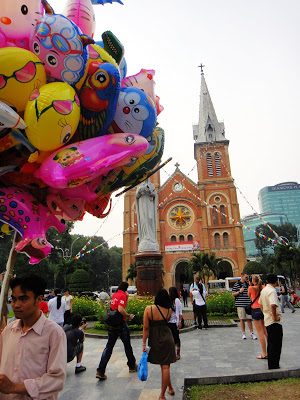 For all the people, I don’t see many children in Saigon. Families here are limited to two children; poor people try to fly under the radar with more, but rich families choose to have just one so they can afford a better education. Cheapest are the public schools, then private schools, with international schools being the most expensive. If kids do well enough in school they’ll get to study abroad for university, so they study all day.
For all the people, I don’t see many children in Saigon. Families here are limited to two children; poor people try to fly under the radar with more, but rich families choose to have just one so they can afford a better education. Cheapest are the public schools, then private schools, with international schools being the most expensive. If kids do well enough in school they’ll get to study abroad for university, so they study all day. This made more sense to me after I found out the school day is from 7-11am or 1-5pm; just half a day. Anyway, we got our Tour de Vietnam off to a quick start despite the mean tour guide, who additionally greeted us with, “This is the most crowded time to come to Vietnam,” (no smile) followed shortly with, “I’m surprised you’re doing your tour like this. You should have arranged it north to south, then gone to Cambodia.”
Then she bossed me multiple times about using foreign currency and told me I’d planned the tour wrong by not leaving more time for Saigon, all said with wrinkle-nosed disdain and no smiling! On top of that, she explained all the booby traps in great detail, even relish. Fortunately we had limited time with her and were able to shake her in time for New Year’s Eve Saigon. Guide be darned, we are excited to be here!